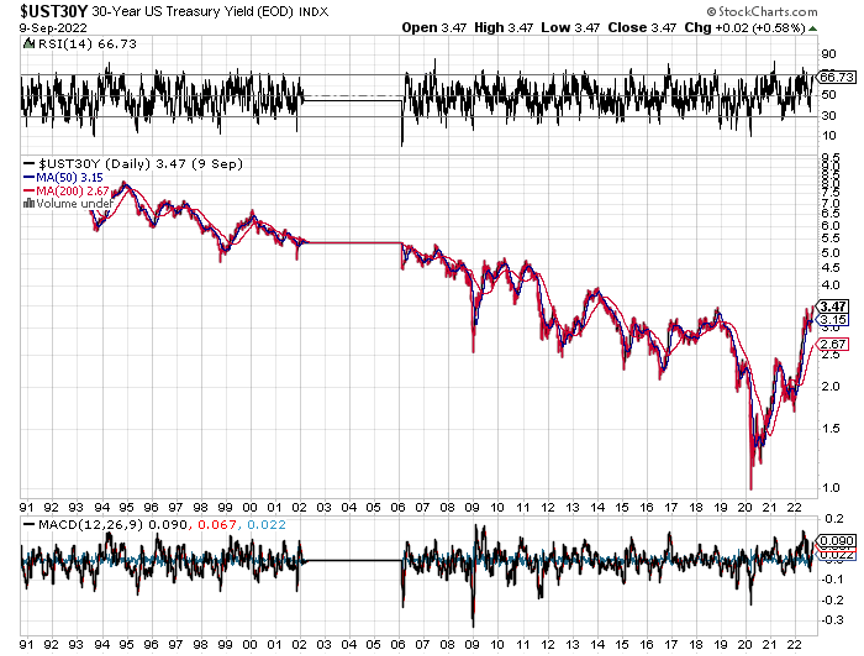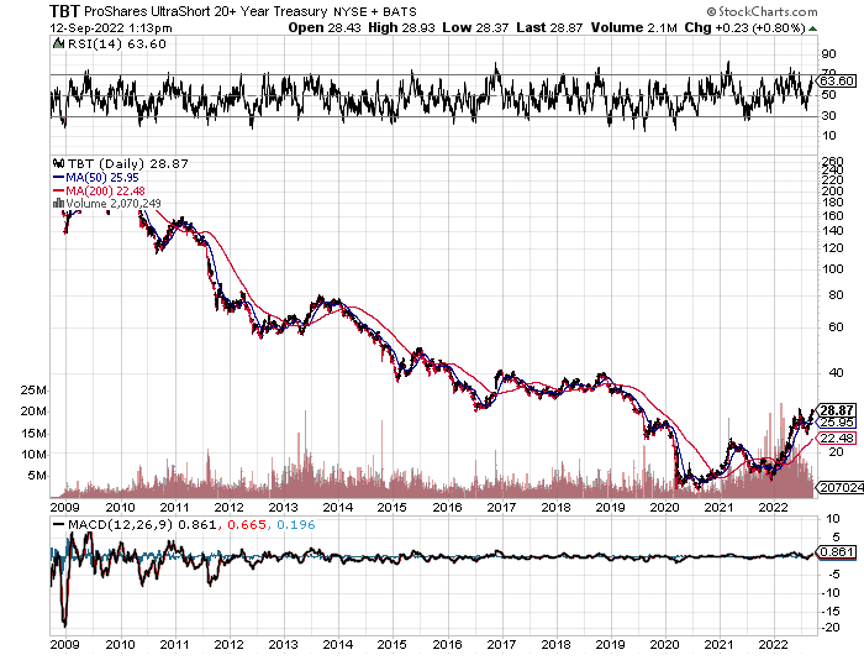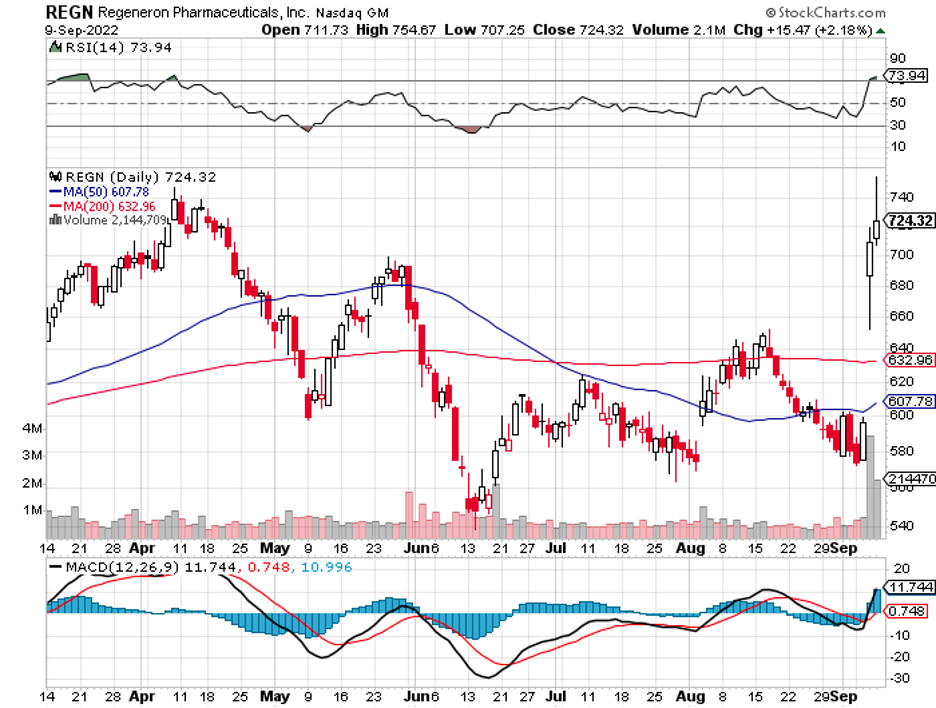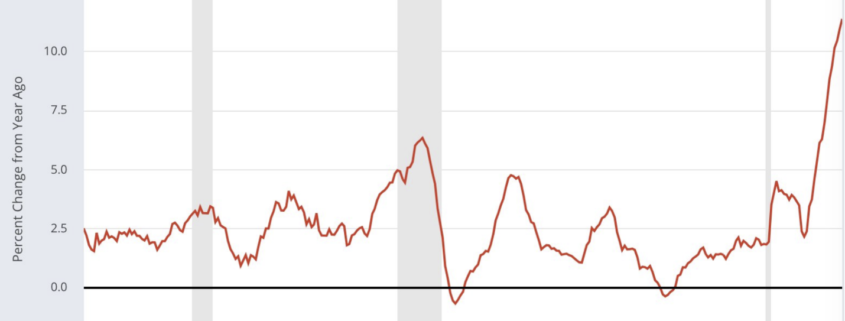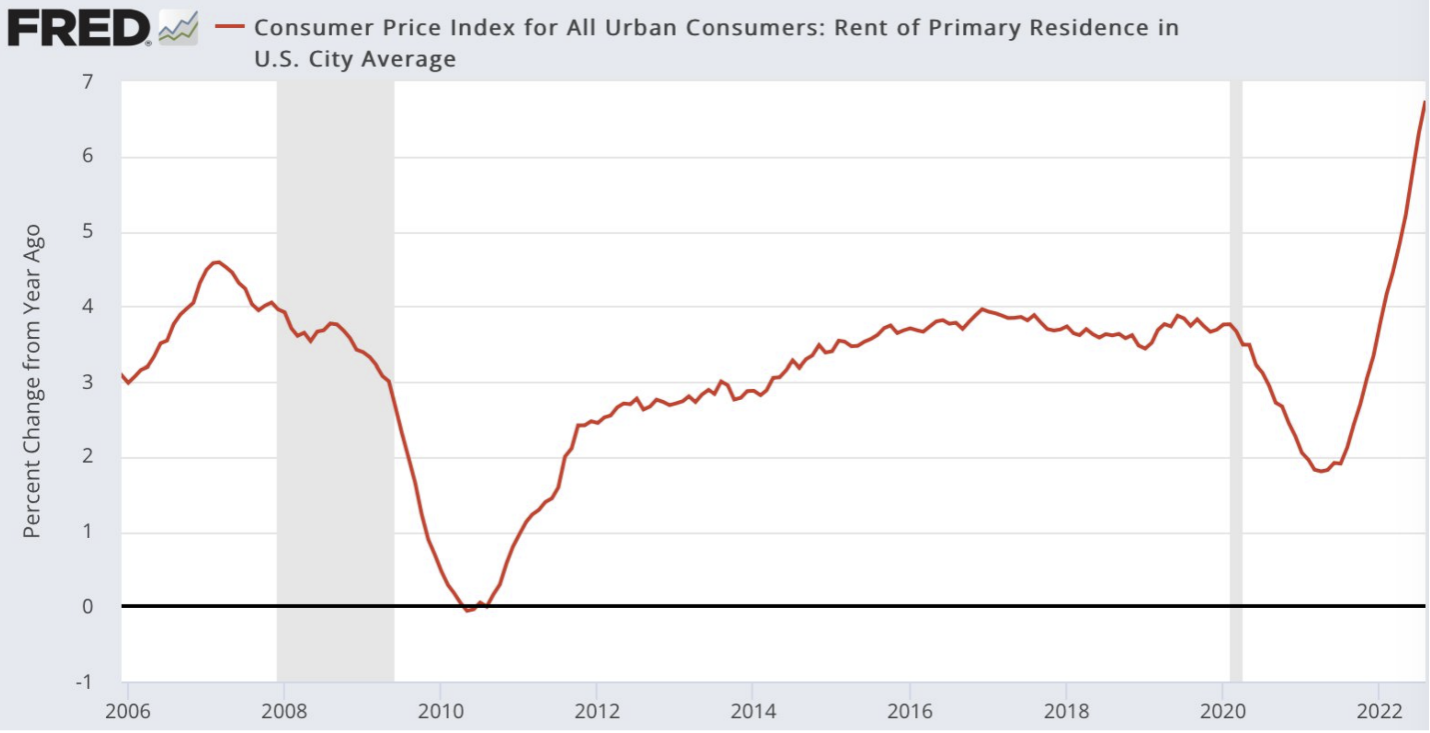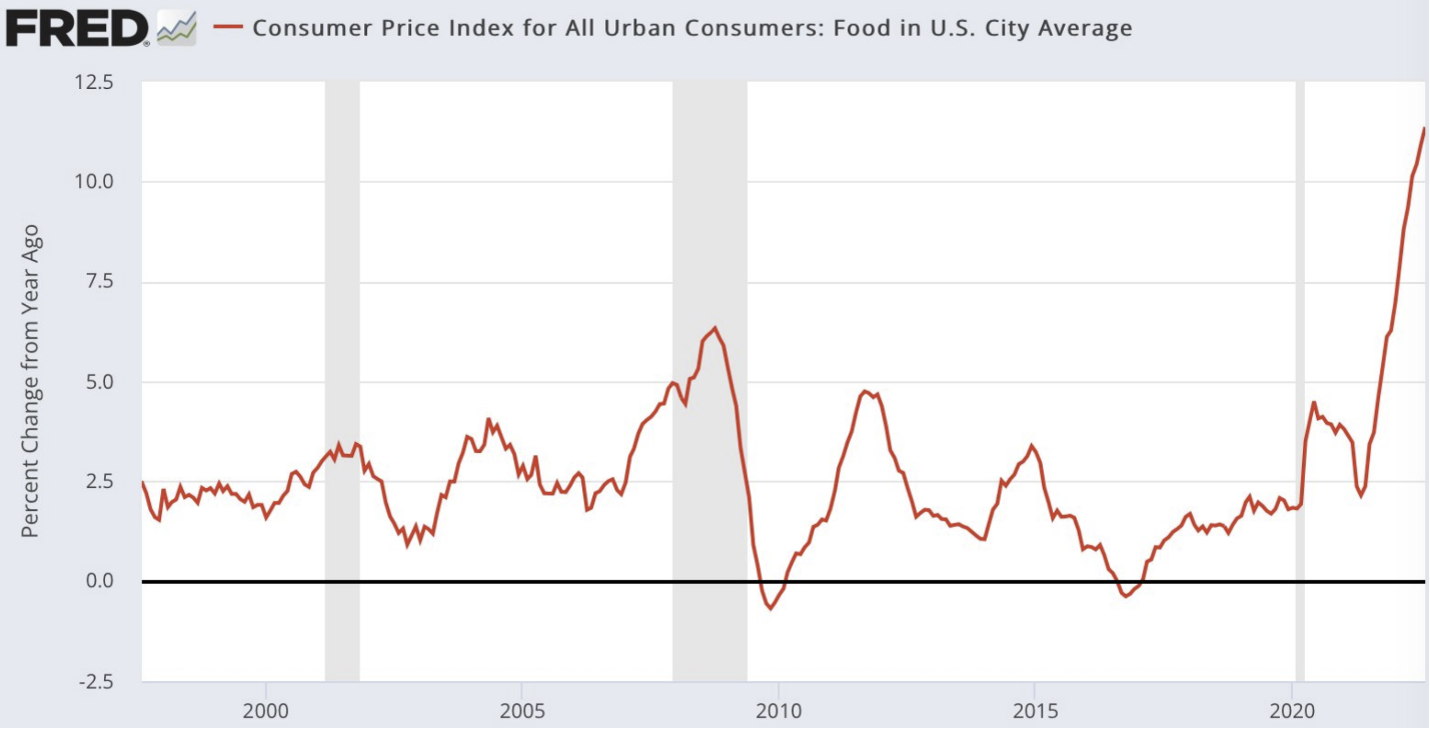When John identifies a strategic exit point, he will send you an alert with specific trade information as to what security to sell, when to sell it, and at what price. Most often, it will be to TAKE PROFITS, but, on rare occasions, it will be to exercise a STOP LOSS at a predetermined price to adhere to strict risk management discipline. Read more
Global Market Comments
September 14, 2022
Fiat Lux
Featured Trade:
(WHAT EVER HAPPENED TO THE GREAT DEPRESSION DEBT?),
($TNX), (TLT), (TBT)
When I was a little kid during the early 1950s, my grandfather used to endlessly rail against Franklin Delano Roosevelt.
The WWI veteran, who was mustard gassed in the trenches of France and was a lifetime, died in the wool Republican, said the former president was a dictator and a traitor to his class, who trampled the constitution with complete disregard.
Republican presidential candidates Hoover, Landon, and Dewey would have done much better jobs.
What was worse, FDR had run up such enormous debts during the Great Depression that, not only would my life be ruined, so would my children’s lives.
As a six-year-old, this disturbed me deeply, as it appeared that just out of diapers, my life was already going to be dull, brutish, and pointless.
Grandpa continued his ranting until a three pack a day Lucky Strike non-filter habit finally killed him in 1977.
He insisted until the day he died that there was no definitive proof that cigarettes caused lung cancer, even though during his war, they referred to them as “coffin nails.”
He was stubborn as a mule to the end. And you wonder whom I got it from?
What my grandfather’s comments did do was spark in me a lifetime interest in the government bond market, not only ours, but everyone else’s around the world.
So, what ever happened to the despised, future destroying Roosevelt debt?
In short, it went to money heaven.
And here I like to use the old movie analogy. Remember, when someone walked into a diner in those old black and white flicks? Check out the prices on the menu on the wall. It says “Coffee: 5 cents, Hamburgers: 10 cents, Steak: 50 cents.”
That is where the Roosevelt debt went.
By the time the 20 and 30-year Treasury bonds issued in the 1930’\s came due, WWII, Korea, and Vietnam happened, and the great inflation that followed.
The purchasing power of the dollar cratered, falling roughly 90%. Coffee is now $1.00, a hamburger at McDonald’s is $5.00, and a cheap steak at Outback cost $12.00.
The government, in effect, only had to pay back 10 cents on the dollar in terms of current purchasing power on whatever it borrowed in the thirties.
Who paid for this free lunch?
Bond owners who received minimal and often negative real inflation-adjusted returns on fixed income investments for three decades.
In the end, it was the risk avoiders who picked up the tab. This is why bonds became known as “certificates of confiscation” during the seventies and eighties.
This is not a new thing. About 300 years ago, governments figured out there was easy money to be had by issuing paper money, borrowing massively, stimulating the local economy, creating inflation, and then repaying the debt in devalued future paper money.
This is one of the main reasons why we have governments, and why they have grown so big. Unsurprisingly, France was the first, followed by England and every other major country.
Ever wonder how the new, impoverished United States paid for the Revolutionary War?
It issued paper money by the bale, which dropped in purchasing power by two thirds by the end of conflict in 1783. The British helped too by flooding the country with counterfeit paper Continental money.
Bondholders can expect to receive a long series of rude awakenings sometime in the future.
No wonder Bill Gross, the former head of bond giant PIMCO, says he will get ashes in his stocking for Christmas next year.
The scary thing is that eventually, we will enter a new 30-year bear market for bonds that lasts all the way until 2049. However, after last month’s frenetic spike up in bond prices and down in bond yields, that is looking more like a 2022 than a 2019 position.
This is certainly what the demographics are saying, which predicts an inflationary blow-off in decades to come that could take short term Treasury yields to a nosebleed 12% high once more.
That scenario has the leveraged short Treasury bond ETF (TBT), which has just cratered down to $23, double to $46, and then soaring all the way to $200.
If you wonder how yields could get that high in a decade, consider one important fact.
The largest buyers of American bonds for the past three decades have been Japan and China. Between them, they have soaked up over $2 trillion worth of our debt, some 12% of the total outstanding.
Unfortunately, both countries have already entered very negative demographic pyramids, which will forestall any future large purchases of foreign bonds. They are going to need the money at home to care for burgeoning populations of old age pensioners.
So who becomes the buyer of last resort? No one, unless the Federal Reserve comes back with QE IV, V, and VI. QE IV, in fact, has already started.
There is a lesson to be learned today from the demise of the Roosevelt debt.
It tells us that the government should be borrowing as much as it can right now with the longest maturity possible at these ultra-low interest rates and spending it all.
With real, inflation adjusted 10-year Treasury bonds now posting negative yields, they have a free pass to do so.
In effect, the government never has to pay back the money. But they do have the ability to reap immediate benefits, such as through stimulating the economy with greatly increased infrastructure spending.
Heaven knows we need it.
If I were king of the world, I would borrow $5 trillion tomorrow and disburse it only in areas that create domestic US jobs. Not a penny should go to new social programs. Long-term capital investments should be the sole target.
Here is my shopping list:
$1 trillion – new Interstate freeway system
$1 trillion – additional infrastructure repairs and maintenance
$1 trillion – conversion of our energy system to solar
$1 trillion – construction of a rural broadband network
$1 trillion – investment in R&D for everything
The projects above would create 5 million new jobs quickly. Who would pay for all of this in terms of lost purchasing power? Today’s investors in government bonds, half of whom are foreigners, principally the Chinese and Japanese. Notice that I am not committing a single dollar in spending on any walls.
How did my life turn out? Was it ruined, as my grandfather predicted?
Actually, I did pretty well for myself, as did the rest of my generation, the baby boomers.
My kids did OK too. One son just got a $1 million, two year package at a new tech startup and he is only 30. Another is deeply involved in the tech industry, and my oldest daughter is working on a PhD at the University of California. My two youngest girls became the first ever female eagle scouts.
Not too shabby.
Grandpa was always a better historian than a forecaster. But he did have the last laugh. He made a fortune in real estate, betting correctly on the inflation that always follows big borrowing binges.
You know the five acres that sits under the Bellagio Hotel in Las Vegas today? That’s the land he bought in 1945 for $500. He sold it 32 years later for $10 million.
Not too shabby either.
32 Years of 30-Year Bond Yields
Not Too Shabby for $500
"There is no more powerful thing than a free market that changes its mind," said Art Cashin, UBS Director of Floor Operations.
Mad Hedge Biotech and Healthcare Letter
September 13, 2022
Fiat Lux
Featured Trade:
(A CROWN JEWEL SCORES A GOAL)
(REGN), (BAYRY), (RHHBY), (SNY), (ALNY), (NTLA)
A stock with high margins offers a better buffer to face adversity and increased expenses.
Suppose a business’s revenue cost is substantial and leaves minimal room for the top line to maneuver and cover overhead and other operating fees. In that case, it can be challenging to stay in the black.
A recent example is Amazon (AMZN), which reports that its cost of sales typically comprises 80% or more of its revenue. When it struggled with the rising expenses in the past quarter, this e-commerce giant posted its first-ever loss in years.
Only a handful of companies manage to stick with this principle. In the biotechnology and healthcare sector, one business that doesn’t have this issue and enjoys gross profit margins of at least 80% or better is Regeneron Pharmaceuticals (REGN).
Regeneron was recently spotlighted following a significant 19.2% jump in its price, translating to a more than $12 billion rise in market capitalization.
The catalyst for this double-digit climb is none other than Regeneron’s crown jewel: Eylea.
The anti-blindness treatment, jointly developed with Bayer (BAYRY), delivered excellent results in two late-stage trials.
This is a huge deal because it supports the application of Eylea at higher doses and longer-lasting intervals.
Previously, Eylea was only permitted to be administered in 2 mg every 8 weeks. The recent trial results proved that the medication can be given at a higher concentration of 8 mg in a more extended period of 16 weeks and can still be effective at battling the disease. Plus, it shows a similar safety profile as the currently approved dosage.
This is a timely development for Eylea, which is set to lose its patent exclusivity soon, bringing anxiety to shareholders.
For context, Eylea accounts for $3.13 billion of Regeneron’s sales in the first 6 months of 2022. In the year's second quarter alone, it generated $2.49 billion in sales, recording a 9% year-over-year increase in its global profits.
In 2021, this eye medication reported $9.4 billion in sales worldwide.
These recent developments are eyed as potential solutions to Eylea’s impending franchise exclusivity loss as it attempts to eliminate a key overhang.
This move could slam the door shut on any talks or fears of potential copycats for at least a few years. It could also make it more competitive against rising competitors in the same space like Roche’s (RHHBY) Vabysmo.
The new data is expected to be used to defend the franchise from biosimilars, generic, and branded competitors. This is because patients are now offered an option for a treatment that needs fewer injections.
Most importantly, this could establish a firmer competitive moat for Regeneron and Bayer. After all, Eylea is projected to rake in more than $6 billion in sales in the US annually in 2023 and 2024.
Looking at their timeline and progress, the new Eylea dosage should be submitted for approval by the end of 2022 and launched by early 2023.
Other than Eylea, Regeneron has also been active in the oncology space.
Leveraging its roughly $6.2 billion sales from its COVID-19 treatment, Regeneron acquired several assets to expand its oncology segment.
Recently reported deals are its $900 million payment to Sanofi (SNY) to acquire non-small lung cancer drug Libtayo and the purchase of Checkmate Pharmaceuticals, which granted it access to promising melanoma candidates.
While these deals may not be as massive as other acquisitions in the industry, adding Libtayo and Checkmate Pharmaceuticals represent critical steps toward the right direction.
On top of these, Regeneron has existing partnerships and collaborations that would last for years. One is with Alnylam (ALNY), which involves treating liver cancer, ocular conditions, and diseases targeting the central nervous system.
Meanwhile, Regeneron expanded its deal with Intellia Therapeutics (NTLA) to give more rights to their in vivo therapeutic candidate developed via CRISPR/Cas9 gene-editing technology and additional targets, particularly for hemophilia A and B.
Overall, Regeneron has been proving to be a noteworthy investment in biotechnology and healthcare. At this point, though, the recent clinical trial results have been added to its share price.
While it isn’t exactly cheap, it’s not an outlandish valuation either. In short, I suggest that you wait and buy the dip.
Mad Hedge Bitcoin Letter
September 13, 2022
Fiat Lux
Featured Trade:
(BITCOIN GETS DROPKICKED)
(BTC), (CPI)
The proof is in the pudding, and this is yet more evidence that it’s impossible to extinguish a forest fire with a bottle of water.
That’s the analogy I would like to trot out as another white-hot inflation number pierces the hearts of team transitory.
Inflation staying at 8.3% year over year is highly negative for the price of Bitcoin, cryptos, and risk assets in general.
Crypto was supposed to be the savior of inflation, but at the time of this writing, the price of Bitcoin (BTC) is down 6% this morning and underperforming the broader Nasdaq market by two times.
Everyone knew that inflation would still come in high, but the 8.3% is highly disappointing as the inflation naysayers had already started to spread the deflation narrative or that inflation has “peaked.”
We are currently stuck in a vicious feedback loop where elevated inflation cannot be contained with the current Central Bank policies.
A low Fed Funds rate of 2.5% cannot crack inflation over 8% and it’s killing the price of crypto and literally destroying the digital coin industry.
At these accommodative rates, the job market is holding up quite well which is what the Fed doesn’t want. Job seekers who lately have gotten cut from technology firms are reappearing with higher paying jobs and better benefits in different parts of the economy.
There is no hope for Bitcoin until the US Central Bank finally tames inflation.
The consumer price index (CPI) rose 8.3% in August from a year earlier, a mild slowdown from the 8.5% reported for July.
Gas prices came down, but other sectors offset those price decreases and caused overall inflation to remain elevated. Health insurance, for example, rose a blistering 24.3% year-over-year, the largest increase ever.
Food at home and rent prices were also one of the main drivers this month, up 13.5% and 15.8%, and services inflation rose above 6%.
The result of all this is that a Bitcoin reversal will be delayed as crypto investors wait for inflation to decrease.
I can’t imagine Bitcoin getting over the $25,000 per coin hump until there is more progress on the inflation front.
This is also negative for crypto infrastructure that is holding on for dear life until the next bull market comes.
Anything bullish in crypto has been effectively pushed back.
The inflation report means that US consumers will deal with a cost-of-living crisis longer than expected which will supersede any crisis in terms of what currency they want to store wealth in.
The larger risk is that the US Central Bank risks losing control of inflation completely as the negative feedback loop can accelerate to the downside which might force the Fed to raise rates to unprecedented levels.
It sure appears that this is morphing into a whack-a-mole phenomenon.
It’s clear that the Fed is being way too generous to equity holders by casually increasing rates at a pedestrian pace. If they lose control of inflation, Bitcoin could go to $10,000 per coin.
The fact is that the US Federal government is the biggest beneficiary of low-interest debt which is now about to touch $31 trillion.
The Fed is doing everything it can to not raise rates more than is needed because it makes servicing the debt and those interest payments too onerous.
The Fed will need to raise rates to keep the Federal government solvent if the risk of hyperinflation increases.
Ultimately, this new inflation report means that inflation will persist longer than expected which will cause the Fed to raise short-term rates faster and higher than expected.
Today was a sucker punch to Bitcoin – the digital is down and out for the time being.
“In the end, a vision without the ability to execute it is probably a hallucination.” – Said Former CEO of AOL Steve Case
Global Market Comments
September 13, 2022
Fiat Lux
Featured Trade:
(THE NEXT COMMODITY SUPERCYCLE HAS ALREADY STARTED),
(COPX), (GLD), (FCX), (BHP), (RIO), (SIL),
(PPLT), (PALL), (GOLD), (ECH), (EWZ), (IDX)
Legal Disclaimer
There is a very high degree of risk involved in trading. Past results are not indicative of future returns. MadHedgeFundTrader.com and all individuals affiliated with this site assume no responsibilities for your trading and investment results. The indicators, strategies, columns, articles and all other features are for educational purposes only and should not be construed as investment advice. Information for futures trading observations are obtained from sources believed to be reliable, but we do not warrant its completeness or accuracy, or warrant any results from the use of the information. Your use of the trading observations is entirely at your own risk and it is your sole responsibility to evaluate the accuracy, completeness and usefulness of the information. You must assess the risk of any trade with your broker and make your own independent decisions regarding any securities mentioned herein. Affiliates of MadHedgeFundTrader.com may have a position or effect transactions in the securities described herein (or options thereon) and/or otherwise employ trading strategies that may be consistent or inconsistent with the provided strategies.




